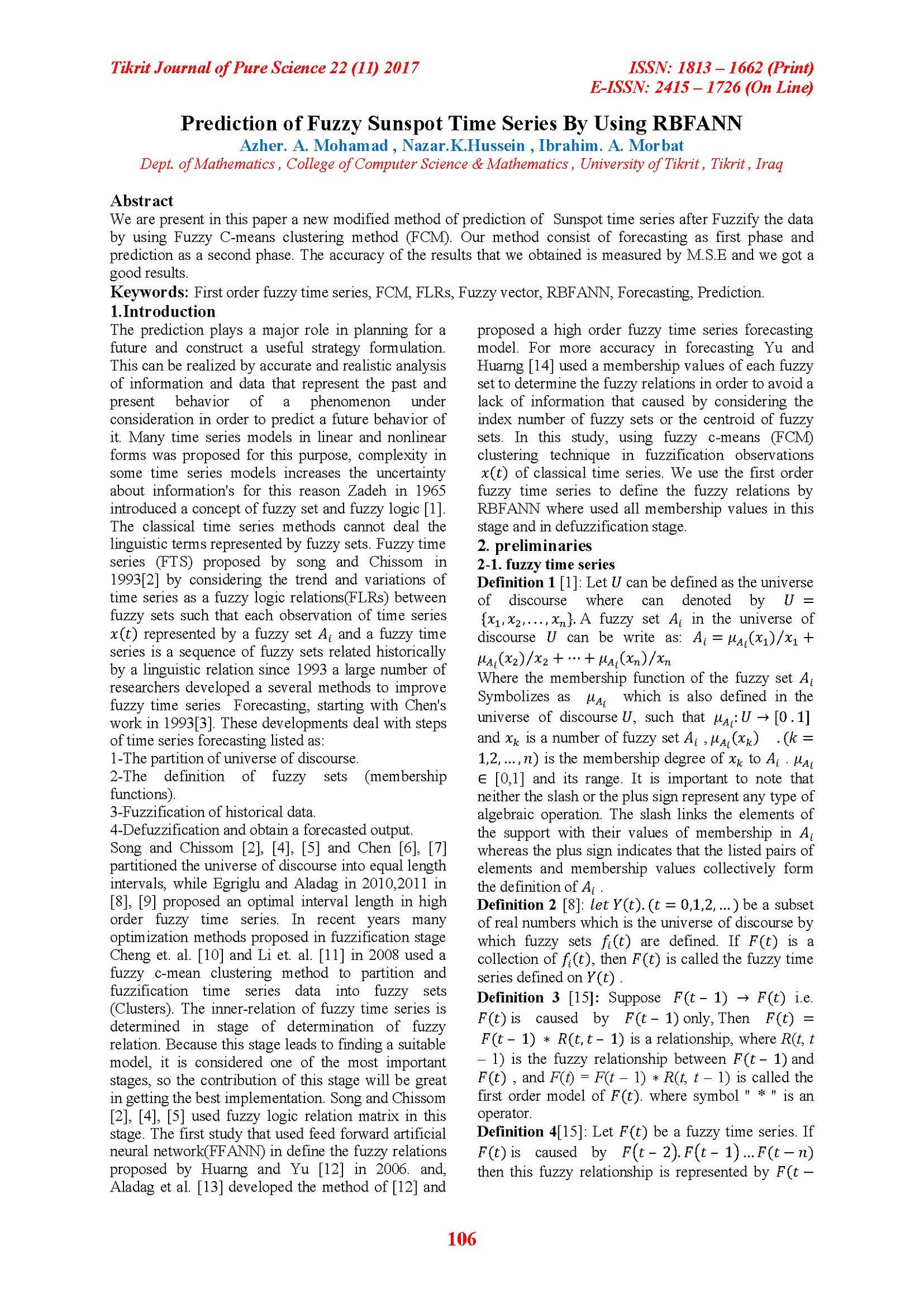Prediction of Fuzzy Sunspot Time Series By Using RBFANN
Main Article Content
Abstract
We are present in this paper a new modified method of prediction of Sunspot time series after Fuzzify the data by using Fuzzy C-means clustering method (FCM). Our method consist of forecasting as first phase and prediction as a second phase. The accuracy of the results that we obtained is measured by M.S.E and we got a good results.
Article Details

This work is licensed under a Creative Commons Attribution 4.0 International License.
Tikrit Journal of Pure Science is licensed under the Creative Commons Attribution 4.0 International License, which allows users to copy, create extracts, abstracts, and new works from the article, alter and revise the article, and make commercial use of the article (including reuse and/or resale of the article by commercial entities), provided the user gives appropriate credit (with a link to the formal publication through the relevant DOI), provides a link to the license, indicates if changes were made, and the licensor is not represented as endorsing the use made of the work. The authors hold the copyright for their published work on the Tikrit J. Pure Sci. website, while Tikrit J. Pure Sci. is responsible for appreciate citation of their work, which is released under CC-BY-4.0, enabling the unrestricted use, distribution, and reproduction of an article in any medium, provided that the original work is properly cited.
References
[1] L. A. Zadeh, Fuzzy sets, Information and Control,
vol. 8(1965), pp. 338-353.
[2] Q. Song, and B.S. Chissom, Fuzzy time series and
its models, Fuzzy Sets and Systems, vol. 54(1993a),
pp. 269-277.
[3] S. M. Chen, Forecasting enrollments based on
fuzzy time series, Fuzzy Sets and Systems, vol.
81(1996), pp. 311–319.
[4] Q. Song and B. S. Chissom, Forecasting
enrollments with fuzzy time series – part I, Fuzzy Sets
and Systems, vol. 54(1993), pp. 1–9.
[5] Q. Song and B. S. Chissom, Forecasting
enrollments with fuzzy time series – part II, Fuzzy
Sets and Systems, vol. 62(1994), pp. 1–8.
[6] S. M. Chen, Forecasting enrollments based on
high-order fuzzy time series, Cybernetics and
Systems, vol. 33(2002), no. 1, pp. 1–16, Jan.
[7] S. M. Chen and N. Y. Wang, Fuzzy forecasting
based on fuzzy-trend logical relationship groups,
IEEE Trans. Systems, Man, and Cybernetics, Part B:
Cybernetics, vol. 40(2010), no. 5 pp. 1343–1358.
[8] E. Egrioglu, C.H. Aladag, U. Yolcu, V.R. Uslu,
V.R., and M.A. Basaran, Finding an optimal interval
length in high order fuzzy time series, Expert
Systems with Applications, vol. 37(2010), pp. 5052-
5055.
[9] E. Egrioglu, C.H. Aladag, U. Yolcu, V.R. Uslu,
V.R., and M.A. Basaran, A new approach based on
the optimization of the length of intervals in fuzzy
time series, Journal of Intelligent and Fuzzy Systems,
vol. 22(2011), pp. 15-19.
[10] C.H. Cheng, G.W. Cheng, and J.W. Wang,
Multi-attribute fuzzy time series method based on
fuzzy clustering, Expert Systems with Applications,
vol. 34(2008), pp. 1235-1242.
[11] S.T. Li, Y.C. Cheng, and S.Y. Lin, A FCMbased
deterministic forecasting model for fuzzy time
series, Computers and Mathematics with
Applications, vol. 56(2008), no.12, pp.3052-3063.
[12] K. Huarng and T. H. K. Yu, The application of
neural networks to forecast fuzzy time series, Physica
A: Statistical Mechanics and its Applications, vol.
363(2006), no. 2, pp. 481-491.
[13] C. H. Aladag, M. A. Basaran, E. Egrioglu, U.
Yolcu and V. R. Uslu, Forecasting in high order
fuzzy times series by using neural networks to define
fuzzy relations, Expert Systems with Applications,
vol. 36(2009), no. 3, pp. 4228-4231.
[14] T. H. K. Yu and K. H. Huarng, a neural networkbased
fuzzy time series model to improve forecasting,
Expert Systems with Applications, vol. 37(2010), no.
4, pp. 3366-3372.
[15] E. Bas, V. Yolcu, E. Egrioglu, and C.H. Aladag,
a fuzzy time series forecasting method based on
operation of union and feedforward artificial neural
network, American Journal of Intelligent Systems,
vol. 5(2015), no. 3, pp.81-91.
[16] J.C. Bezdek, Pattern recognition with fuzzy
objective function algorithms, Plenum Press, N.Y.,
1981.
[17] P.M. Seneha and A.U. Bapat, clustering
algorithms for radial basis function neural network,
Transaction on Electrical and Electronic Engineering,
vol. 1(2013), no.1, pp.113-116.
[18] C.M. Bishop, Neural Networks for Pattern
Recognition, Oxford university press, 1995.
[19] W. Pedrycz, Conditional Fuzzy C-means,
Pattern Recognition Letters, vol. 17(1996), no. 2, pp.
625-632.
